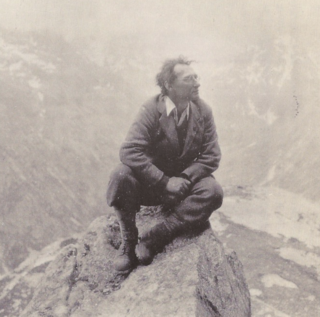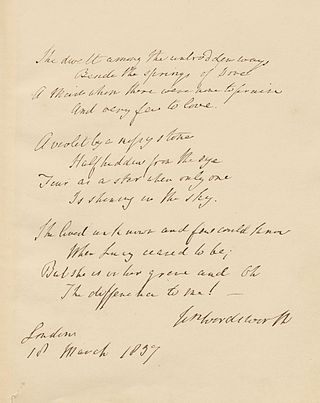Related Research Articles

Poetry, also called verse, is a form of literature that uses aesthetic and often rhythmic qualities of language − such as phonaesthetics, sound symbolism, and metre − to evoke meanings in addition to, or in place of, a prosaic ostensible meaning. A poem is a literary composition, written by a poet, using this principle.

Literary criticism is the study, evaluation, and interpretation of literature. Modern literary criticism is often influenced by literary theory, which is the philosophical discussion of literature's goals and methods. Though the two activities are closely related, literary critics are not always, and have not always been, theorists.

A figure of speech or rhetorical figure is a word or phrase that intentionally deviates from ordinary language use in order to produce a rhetorical effect. Figures of speech are traditionally classified into schemes, which vary the ordinary sequence of words, and tropes, where words carry a meaning other than what they ordinarily signify.

In literary criticism, close reading is the careful, sustained interpretation of a brief passage of a text. A close reading emphasizes the single and the particular over the general, effected by close attention to individual words, the syntax, the order in which the sentences unfold ideas, as well as formal structures. A truly attentive close reading means thinking about both what is being said in a passage, and how it is being said and leading it to possibilities for observation and insight.
New Criticism was a formalist movement in literary theory that dominated American literary criticism in the middle decades of the 20th century. It emphasized close reading, particularly of poetry, to discover how a work of literature functioned as a self-contained, self-referential aesthetic object. The movement derived its name from John Crowe Ransom's 1941 book The New Criticism.

Ivor Armstrong Richards CH, known as I. A. Richards, was an English educator, literary critic, poet, and rhetorician. His work contributed to the foundations of the New Criticism, a formalist movement in literary theory which emphasized the close reading of a literary text, especially poetry, in an effort to discover how a work of literature functions as a self-contained and self-referential æsthetic object.
William Kurtz Wimsatt Jr. was an American professor of English, literary theorist, and critic. Wimsatt is often associated with the concept of the intentional fallacy, which he developed with Monroe Beardsley in order to discuss the importance of an author's intentions for the creation of a work of art.

Cleanth Brooks was an American literary critic and professor. He is best known for his contributions to New Criticism in the mid-20th century and for revolutionizing the teaching of poetry in American higher education. His best-known works, The Well Wrought Urn: Studies in the Structure of Poetry (1947) and Modern Poetry and the Tradition (1939), argue for the centrality of ambiguity and paradox as a way of understanding poetry. With his writing, Brooks helped to formulate formalist criticism, emphasizing "the interior life of a poem" and codifying the principles of close reading.

"Ode on a Grecian Urn" is a poem written by the English Romantic poet John Keats in May 1819, first published anonymously in Annals of the Fine Arts for 1819.
In literature and writing, stylistically elements are the use of any of a variety of techniques to give an auxiliary meaning, ideas, or feeling to the literalism or written.

Understanding Poetry was an American college textbook and poetry anthology by Cleanth Brooks and Robert Penn Warren, first published in 1938. The book influenced New Criticism and went through its fourth edition in 1976.

"Composed upon Westminster Bridge, September 3, 1802" is a Petrarchan sonnet by William Wordsworth describing London and the River Thames, viewed from Westminster Bridge in the early morning. It was first published in the collection Poems, in Two Volumes in 1807.

"Ode: Intimations of Immortality from Recollections of Early Childhood" is a poem by William Wordsworth, completed in 1804 and published in Poems, in Two Volumes (1807). The poem was completed in two parts, with the first four stanzas written among a series of poems composed in 1802 about childhood. The first part of the poem was completed on 27 March 1802 and a copy was provided to Wordsworth's friend and fellow poet, Samuel Taylor Coleridge, who responded with his own poem, "Dejection: An Ode", in April. The fourth stanza of the ode ends with a question, and Wordsworth was finally able to answer it with seven additional stanzas completed in early 1804. It was first printed as "Ode" in 1807, and it was not until 1815 that it was edited and reworked to the version that is currently known, "Ode: Intimations of Immortality".

"The Heresy of Paraphrase" is the title of a chapter in The Well-Wrought Urn, a seminal work of the New Criticism by Cleanth Brooks. Brooks argued that meaning in poetry is irreducible, because "a true poem is a simulacrum of reality...an experience rather than any mere statement about experience or any mere abstraction from experience." Brooks emphasized structure, tension, balance, and irony over meaning, statement, and subject matter. He relied on comparisons with non-verbal arts in order to shift discussion away from summarizable content:
The essential structure of a poem resembles that of architecture or painting: it is a pattern of resolved stresses. Or, to move closer still to poetry by considering the temporal arts, the structure of a poem resembles that of a ballet or musical composition. It is a pattern of resolutions and balances and harmonization, developed through a temporal scheme.

"She Dwelt Among the Untrodden Ways" is a three-stanza poem written by the English Romantic poet William Wordsworth in 1798 when he was 28 years old. The verse was first printed in Lyrical Ballads, 1800, a volume of Wordsworth's and Samuel Taylor Coleridge's poems that marked a climacteric in the English Romantic movement. The poem is the best known of Wordsworth's series of five works which comprise his "Lucy" series, and was a favorite amongst early readers. It was composed both as a meditation on his own feelings of loneliness and loss, and as an ode to the beauty and dignity of an idealized woman who lived unnoticed by all others except by the poet himself. The title line implies Lucy lived unknown and remote, both physically and intellectually. The poet's subject's isolated sensitivity expresses a characteristic aspect of Romantic expectations of the human, and especially of the poet's condition.

"The Canonization" is a poem by English metaphysical poet John Donne. First published in 1633, the poem is viewed as exemplifying Donne's wit and irony. It is addressed to one friend from another, but concerns itself with the complexities of romantic love: the speaker presents love as so all-consuming that lovers forgo other pursuits to spend time together. In this sense, love is asceticism, a major conceit in the poem. The poem's title serves a dual purpose: while the speaker argues that his love will canonise him into a kind of sainthood, the poem itself functions as a canonisation of the pair of lovers.

The Well Wrought Urn: Studies in the Structure of Poetry is a 1947 collection of essays by Cleanth Brooks. It is considered a seminal text in the New Critical school of literary criticism. The title contains an allusion to the fourth stanza of John Donne's poem, "The Canonization", which is the primary subject of the first chapter of the book.

The Lucy poems are a series of five poems composed by the English Romantic poet William Wordsworth (1770–1850) between 1798 and 1801. All but one were first published during 1800 in the second edition of Lyrical Ballads, a collaboration between Wordsworth and Samuel Taylor Coleridge that was both Wordsworth's first major publication and a milestone in the early English Romantic movement. In the series, Wordsworth sought to write unaffected English verse infused with abstract ideals of beauty, nature, love, longing and death.

"I travelled among unknown men" is a love poem completed in April 1801 by the English poet William Wordsworth and originally intended for the Lyrical Ballads anthology, but it was first published in Poems, in Two Volumes in 1807. The third poem of Wordsworth's "Lucy series", "I travelled..." was composed after the poet had spent time living in Germany in 1798. Due to acute homesickness, the lyrics promise that once returned to England, he will never live abroad again. The poet states he now loves England "more and more". Wordsworth realizes that he did not know how much he loved England until he lived abroad and uses this insight as an analogy to understand his unrequited feelings for his beloved, Lucy.
"It is a beauteous evening, calm and free" is a sonnet by William Wordsworth written at Calais in August 1802. It was first published in the collection Poems, in Two Volumes in 1807, appearing as the nineteenth poem in a section entitled 'Miscellaneous sonnets'.
References
- ↑ Rescher, Nicholas. Paradoxes: Their Roots, Range, and Resolution. Open Court: Chicago, 2001.
- 1 2 From "A Tall Story" in The Paradoxes of Mr. Pond .
- ↑ Literary Theory: An Anthology, 2nd Ed., Eds. Julie Rivkin and Michael Ryan.
- 1 2 Brooks, Cleanth. The Well Wrought Urn: Studies in the Structure of Poetry . New York: Reynal & Hitchcock, 1947.
- ↑ William Wordsworth (1802). "It is a beauteous evening, calm and free". Bartelby dot org. Retrieved 2011-11-16.
- 1 2 Brooks, Cleanth. "Irony as a Principle of Structure." In Critical Theory Since Plato, edited by Hazard Adams. New York: Harcourt Brace Jovanovich, Inc., 1971.
- 1 2 Crane, R.S. "Cleanth Brooks; Or, The Bankruptcy of Critical Monism." In Modern Philology, Vol. 45, No. 4 (May 1948) pp 226–245.
- ↑ Searle, Leroy. "New Criticism." In The Johns Hopkins Guide to Literary Theory and Criticism, 2nd edition. Edited by Michael Groden, Martin Kreiswirth, and Imre Szeman. Baltimore: Johns Hopkins University Press, 2005.